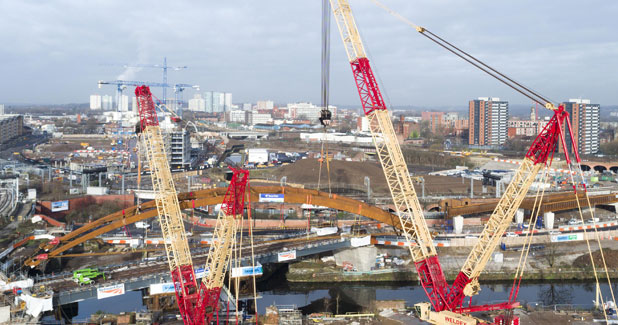
Liebherr crawler cranes complete tandem hoist of Manchester bridge
As part of a major railway construction project in the North of England, the Scottish contractor Weldex used two Liebherr crawler cranes to complete a central construction phase. Recently both crawler cranes performed a tandem hoist for a 560-tonne arched bridge over the River Irwell in Manchester. The new railway bridge will link the city?s Piccadilly and Victoria stations.
The LR 1750 started work at the site in Manchester in July 2016. The 750-tonne crane was used for six months to set up the lower section of the bridge immediately over the river and to assemble the 90-meter bridge arch. The massive steel structure had previously been transported to the site in the centre of the city in small segments.
Weldex sent its crawler crane to the site for the subsequent installation of the bridge arch using a tandem hoist. The assemblers erected the Liebherr LR 11350 with a 72-m main boom and the 42-m derrick boom over a period of four days for the job. The large crane would have to handle the majority of the weight and position one end of the bridge arch on the opposite bank of the River Irwell.
This hoist constituted a massive load case for the LR 11350 as a result of the required radius of 51 m. The 357-tonne gross load could only be managed at this distance because the extended guide frame on this crane model makes it possible to extend the radius of the derrick ballast pallet from 25 to 30 m. This configuration of the crane, known as SLDB2, enables it to handle an additional load case of almost 50 tonne with a radius of around 50 m.
However, before the enormous bridge arch could be hoisted over the river, the crawler cranes had to move it around 30 m in stages up to the bank. The synchronous transport was interrupted several times because the cranes had to be fitted with additional ballast. An LTR 1100 telescopic crawler crane stacked the derrick ballast of the LR 11350 up to the maximum of 600 tonne. Together with the central and turntable ballast, ultimately there were 830 tonne of counterweights on the crane. The actual hoist over the water then took place slowly and with no complications with a great deal of care and precision. The bridge arch was in position within three hours after the load had been picked up.
The LR 1750 started work at the site in Manchester in July 2016. The 750-tonne crane was used for six months to set up the lower section of the bridge immediately over the river and to assemble the 90-meter bridge arch. The massive steel structure had previously been transported to the site in the centre of the city in small segments.
Weldex sent its crawler crane to the site for the subsequent installation of the bridge arch using a tandem hoist. The assemblers erected the Liebherr LR 11350 with a 72-m main boom and the 42-m derrick boom over a period of four days for the job. The large crane would have to handle the majority of the weight and position one end of the bridge arch on the opposite bank of the River Irwell.
This hoist constituted a massive load case for the LR 11350 as a result of the required radius of 51 m. The 357-tonne gross load could only be managed at this distance because the extended guide frame on this crane model makes it possible to extend the radius of the derrick ballast pallet from 25 to 30 m. This configuration of the crane, known as SLDB2, enables it to handle an additional load case of almost 50 tonne with a radius of around 50 m.
However, before the enormous bridge arch could be hoisted over the river, the crawler cranes had to move it around 30 m in stages up to the bank. The synchronous transport was interrupted several times because the cranes had to be fitted with additional ballast. An LTR 1100 telescopic crawler crane stacked the derrick ballast of the LR 11350 up to the maximum of 600 tonne. Together with the central and turntable ballast, ultimately there were 830 tonne of counterweights on the crane. The actual hoist over the water then took place slowly and with no complications with a great deal of care and precision. The bridge arch was in position within three hours after the load had been picked up.


 +91-22-24193000
+91-22-24193000 Subscriber@ASAPPinfoGlobal.com
Subscriber@ASAPPinfoGlobal.com